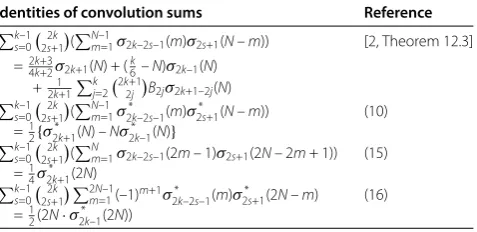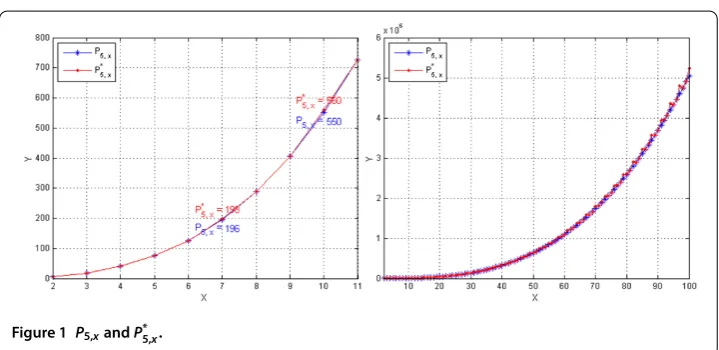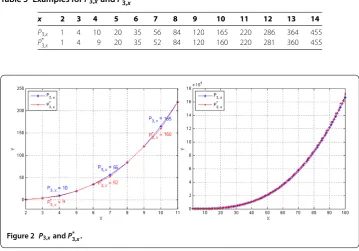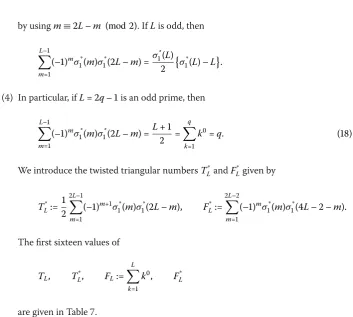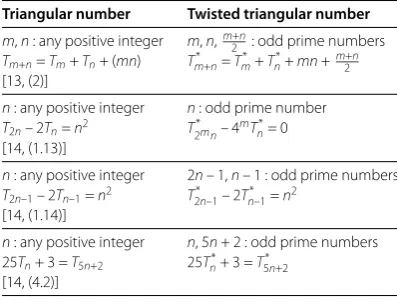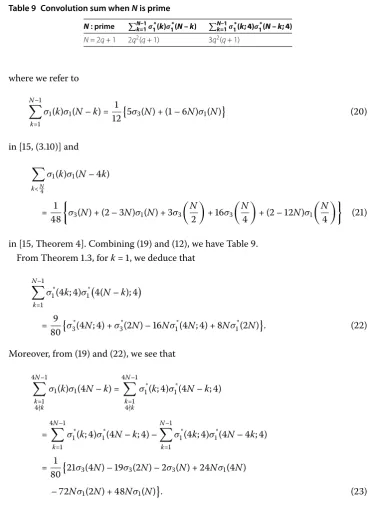R E S E A R C H
Open Access
Convolution identities for twisted Eisenstein
series and twisted divisor functions
Daeyeoul Kim
1and Abdelmejid Bayad
2**Correspondence:
abayad@maths.univ-evry.fr
2Département de mathématiques,
Université d’Evry Val d’Essonne, Bâtiment I.B.G.B.I., 3ème étage, 23 Boulevard de France, 91037 Evry cedex, France
Full list of author information is available at the end of the article
Abstract
We are motivated by Ramanujan’s recursion formula for sums of the product of two Eisenstein series (Berndt in Ramanujan’s Notebook, Part II, 1989, Entry 14, p.332) and its proof, and also by Besge-Liouville’s convolution identity for the ordinary divisor function
σ
k–1(n) (Williams in Number Theory in the Spirit of Liouville, vol. 76, 2011,Theorem 12.3). The objective of this paper is to introduce and prove convolution identities for the twisted divisor functions
σ
*k–1(n) as well as for the twisted Eisenstein
seriesS2k+2,χ0andS2k+2,χ1,S*2k+2,S*2k+2,χ0, andS
*
2k+2,χ1. As applications based on our main results, we establish many interesting identities for pyramidal, triangular, Mersenne, and perfect numbers. Moreover, we show how our main results can be used to obtain arithmetical formulas for the number of representations of an integer
nas the sums ofssquares.
1 Introduction and statement of main results
Throughout this paper, letH={τ∈C|Imτ> }be the complex upper half-plane. LetSk denote the normalized Eisenstein series of weightkdefined onHby
Sk:=Sk(τ) = –
Bk k+
∞
n=
σk–(n)qn, ()
whereσk–(n) =
d|ndk–,q=e
πiτ, andB
kis thekth Bernoulli number. LetS*
k,S*k,χ, andS *
k,χbe the twisted Eisenstein series defined by
S*k:=S*k(τ) =Sk(τ) –Sk(τ)
=
∞
n=
σk–(n) –σk–
n
qn=
∞
n=
σk*–(n)qn. ()
Fori= , , we define the twisted Eisenstein series by
Sk,χi(τ) :=
∞
n=
χi(n)σk–(n), S*k,χi(τ) :=
∞
n=
χi(n)σk*–(n)qn, ()
whereσ*
k–(n) is the twisted divisor function given by
σk*–(n) =
d|n,ndodd dk–,
χ(n) = ⎧ ⎨ ⎩
, ifnis odd,
, otherwise and
χ(n) = ⎧ ⎨ ⎩
, ifnis even,
, otherwise.
Consider the differential operatorD= πi
d dτ =q
d
dqsuch that
D
∞
n= anqn
=
∞
n= nanqn.
We are motivated by Ramanujan’s recursion formula forSn+[, Entry , p.] and its proof, and also by Besge-Liouville’s convolution identity for the divisor functionσk–(n) [, Theorem .]. Inspired by these identities, we prove new identities for the convolu-tion sums of various divisor funcconvolu-tions σk–(n),σk*–(n) as well as recursion formulas for the twisted Eisenstein seriesS*k+,S*k+,χ, andS
*
k+,χ. Several arithmetical applications based on our results are given.
The problem of convolution sums of the divisor functionσ(n) and the theory of Eisen-stein series has recently attracted considerable interest with the emergence of quasimod-ular tools. For further details, we can refer to the works of Royer [], Ramakrishnan and Sahu [], and Alaca and Williams [, ], and the references therein. In connection with the classical Jacobi theta and Euler functions, other aspects of the functionσ(n) are explored by Adiga in [] and by Simsek in []. In this paper, we prove the following results. First, we state the most important identities for the convolution sums of divisor functions as follows.
Theorem . Let k∈Nand N∈N,where k,N≥.We have the identities in Table.
Our next results follow from the identities in Theorem .. Thus, we obtain the following identities for the Eisenstein series.
Theorem . Let k∈Nand n∈N,where k,n≥.We have the identities in Table.
Letpbe a prime number, and letlbe any positive integer. We introduce the twisted divisor function
σs*N;pl:=
d|N,Nd≡ (modpl)
ds.
Table 1 Identities of divisor functions
Identities of convolution sums Reference
k–1
s=0
2k
2s+1
(Nm–1=1σ2k–2s–1(m)σ2s+1(N–m))
=2k+3
4k+2σ2k+1(N) + (
k
6–N)σ2k–1(N)
+ 1 2k+1
k j=2
2k+1 2j
B2jσ2k+1–2j(N)
[2, Theorem 12.3]
k–1
s=0
2k
2s+1
(Nm–1=1σ*
2k–2s–1(m)σ2*s+1(N–m))
=1 2{σ
*
2k+1(N) –Nσ2*k–1(N)}
(10)
k–1
s=0
2k
2s+1
(Nm=1σ2k–2s–1(2m– 1)σ2s+1(2N– 2m+ 1))
=14σ* 2k+1(2N)
(15)
k–1
s=0
2k
2s+1 2N–1
m=1(–1)m+1σ2*k–2s–1(m)σ2*s+1(2N–m)
=12(2N·σ* 2k–1(2N))
Table 2 Identities of divisor functions
Identities of Eisenstein series Reference
–(n2+2)(n(nn–1)+3)Sn+2= –20
n–2 2
S4Sn–2
+[(r=1n–2)/4]n2–2r{(n+ 3 – 5r)(n– 8 – 5r) – 5(r– 2)(r+ 3)}S2r+2Sn–2r
[1, Entry 14, p. 332]
S*
2n+2(τ) =D(S*2n(τ)) + 2ns=0–1
2n
2s+1
S*2n–2s(τ)S*2s+2(τ)
Theorem 3.2
S*
2k+2,χ0(τ) = 4
k–1
s=0
2k
2s+1
S* 2k–2s,χ1(τ)S
* 2s+2,χ1(τ)
= 4ks=0–122s+1kS2k–2s,χ1(τ)S2s+2,χ1(τ)
Lemma 3.3
D(S*
2k,χ0(τ)) = 2
k–1
s=0
2k
2s+1
×(S*2k–2s,χ
1(τ) –S *
2k–2s,χ0(τ))S * 2s+2(τ)
Lemma 3.3
We define
n m
{p,l}
:= (
pln–
pn–)
(pplmm––)(p l(n–m)–
pn–m– )
n m
. ()
In Section . , we establish the following less definitive result.
Theorem . Let k≥and N,l≥.
k–
s=
k
s+
{,l} N–
m=
σ*k–s–lm; lσ*s+l(N–m); l
=
lσ
* k+
lN; l– lNσ* k–
lN; l
+ l–
i= i+σ
* k+
iN; i+N l–
i= iσ*
k–
iN; i
.
Finally, in the last Section , we show how to apply our main results to study some ques-tions related to the famous problem
σ(n) =σ(n+ )
and its variants. Moreover, we consider similar questions on the arithmetic functionσ* (n). Many remarks and results are established.
2 Thepsth scalar multiplicative function
Letpbe a prime number, and letibe a nonnegative integer. A functionf:N→Cis called apithscalar functioniff(px) =pif(x) for all integersx.
Moreover, apith scalar functionf(x) is called apithscalar multiplicative functionif and only iff(xy) =f(x)f(y) for all positive integersx,ysuch that (x,y) = .
Example .
. Letf(x) =x. Thenf(x)is apth scalar multiplicative function. . Letsbe a nonnegative integer; we recall that
σs*(N;p) =
d|N,Nd≡ (modp)
and we define the function
σs,r(N;m) =
d|N,d≡r (modm) ds.
Then the functionσs(N;p) :=pr=–σs,r(N;p)is apth scalar multiplicative function.
. The functionσ,(N; )is ath scalar multiplicative function.
Theorem . The divisor functionσs*(N;p)is a psth scalar multiplicative function.
Proof Letrl=pmNandl= (modp) for somer,l∈Nand primep. Sinceldoes not divide
p, we can writer=pmdfor somed∈N. Therefore, we have
σs*pmN;p=
r|pmNpmNr ≡ (modp)
rs=
d|NNd≡ (modp)
pmds
=pms
d|N N
d≡ (modp)
ds=pmsσs*(N;p). ()
We claim thatσs*(MN;p) =σs*(M;p)σs*(N;p), where (M,N) = . IfpMN, then
σs*(MN;p) =σs(MN) =σs(M)σs(N) =σs*(M;p)σs*(N;p).
Assume thatp|MandpNandM=plM. Hence, we have
σs*(MN;p) =σs*plMN;p=plσs*MN;p
=plσs*M;pσs*(N;p) =σs*plM;pσs*(N;p). ()
Thereforeσ*
s(MN;p) =σs*(M;p)σs*(N;p). Then we get the theorem.
Proposition . Let N∈N.For nonnegative integers m and n,we have
N–
k=
σi*pmk;pmσj*pn(N–k);pn=pi+j(p
im– )(pjn– )
(pi– )(pj– ) N–
k=
σi*(k;p)σj*(N–k;p).
Proof We can see that
N–
k=
σi*pmk;pmσj*pn(N–k);pn
= N–
k=
σi
pmk–σi(k)
σj
pn(N–k)–σj(N–k)
Then, by Theorem ., we have
σi
pmk–σ i(k) =
σi
pmk–σ i
pm–k+σ
i
pm–k–σ
i
pm–k
+σi
pm–k–σi
pm–k+· · ·
+σi
pk–σi(pk)
+σi(pk) –σi(k)
=σi*pmk;p+σi*pm–k;p+σi*pm–k;p+· · ·
+σi*pk;p+σi*(pk;p)
=pmi+p(m–)i+p(m–)i+· · ·+pi+piσi*(k;p)
=pip
mi–
pi– σ
*
i(k;p). ()
Thus, using (), we can write () as
N–
k=
σi*pmk;pmσj*pn(N–k);pn= N–
k=
pip
mi–
pi– σ
*
i(k;p)
pjp
nj–
pj– σ
*
j(N–k;p)
.
3 Convolution relations on twisted Eisenstein series and their applications
3.1 Convolution relations on the twisted Eisenstein seriesS*2n+2(
τ
)We quote the following lemma from [, Chap. , p.].
Lemma . Let f :Z→Cbe an even function.Let n∈N.Then
(a,b,x,y)∈Nax+by=nx,yodd
f(a–b) –f(a+b)
=f()σ(n/) +
d∈N d|n
n d–d
f(d) – d∈N d|n/
n d–d
f(d).
Using the above lemma, we can prove our next result.
Theorem . Let n> .Then
S*n+(τ) =DS*n(τ)+ n–
s=
n
s+
S*n–s(τ)S*s+(τ). ()
Proof We takef(x) =xkin Lemma .. The left-hand side of Lemma . is
(a,x,b,y)∈N
ax+by=n x,yodd
(a–b)k– (a+b)k
=
(a,x,b,y)∈N
ax+by=n x,yodd
k
r=
k r
(–)rak–rbr– k
r=
k r
ak–rbr
= – (a,x,b,y)∈N
ax+by=n x,yodd
k r= rodd k r ak–rbr
= – k– s= k
s+
(a,x,b,y)∈N
ax+by=n x,yodd
ak–s–bs+
= – k– s= k
s+
n–
m=
σ*k–s–(m)σ*s+(n–m).
Therefore, we deduce that
k–
s=
k
s+ N–
m=
σ*k–s–(m)σ*s+(N–m)
=
σ*k+(N) –Nσ*k–(N). ()
From () and (), we get the theorem.
3.2 Proof of Theorem 1.3
From () and (), we obtain
k–
s=
k
s+
{,l} N–
m=
σ*k–s–lm; lσ*s+l(N–m); l
= k–
s=
k(lk– ) k–
k–
s=
k
s+
N–
m=
σ*k–s–(m)σ*s+(N–m)
= k–
s=
k(lk– ) k– ·
σ*k+(N) –Nσ*k–(N)
=
kl+ k(l–)+· · ·+ (k)+ kσ*k+(N)
–Nkl+ k(l–)+· · ·+ (k)+ kσ*k–(N). ()
Then, the first term on the right-hand side of () can be written as
kl+ k(l–)+· · ·+ (k)+ kσ* k+(N)
=
(l)k+ l +
(l–)k+ l– +· · ·+
()k+ +
k+
σ*k+(N)
= lσ
* k+
lN+ l–σ
* k+
l–N+· · ·+ σ
* k+
N+ σ
* k+(N)
=
lσk+
lN– lσk+
l–N+
l–σk+
l–N– l–σk+
l–N
+· · ·+
σk+
N–
σk+(N)
+
σk+(N) –
σk+(N)
= l
σk+
lN–σk+(N)
+ l
σk+
l–N–σk+(N)
+
σk+(N) –σk+(N)
= lσ
* k+
lN; l+ lσ
* k+
l–N; l–+ l–σ
* k+
l–N; l–
+· · ·+ σ
*
k+(N; ).
Similarly, the second term on the right-hand side of () is
–Nkl+ k(l–)+· · ·+ (k)+ kσ*k–(N)
= –Nlσ* k–
lN; l– l–σ* k–
l–N; l––· · ·– σ*
k–(N; )
.
Therefore, the proof is completed.
3.3 Pyramidal numbers
Letαbe a fixed integer withα≥, and let
Pyrα(x) = x(x+ )
(α– )x+ –α
denote theαth order pyramid number []. These combinatorial numbers play an impor-tant role in number theory and discrete mathematics. Using () withk= , we derive
N–
m=
σ*(m)σ*(N–m) =
σ*(N) –Nσ*(N). ()
Proposition . is a very efficient formula for the computation of the sum
N–
k=
σi*pmk;pmσj*pn(N–k);pn.
For example, using Proposition . and (), we get the interesting formulas in Table .
. The pyramidal numbersP,xare closely connected to the convolution sums
N–
m=
σ*(m)σ*(N–m).
Table 3 Values ofNk=1–1σ*
1(2mk; 2m)σ1*(2m(N–k); 2m)
N–1 k=1σ1*(2k)σ
* 1(2(N–k))
N–1
k=1σ1*(4k; 4)σ *
1(4(N–k); 4) ···
N–1
k=1σ1*(2mk; 2m)σ *
1(2m(N–k); 2m) (2 – 1)2(σ*
3(N) –Nσ1*(N)) (4 – 1)2(σ3*(N) –Nσ1*(N)) · · · (2m– 1)2(σ3*(N) –Nσ1*(N))
Table 4 Examples forP5,xandP*5,x
x 2 3 4 5 6 7 8 9 10 11 12 13 14
P5,x 6 18 40 75 126 196 288 405 550 726 936 1,183 1,470
In fact, ifN= q+ is a prime number, then from(), we obtain
q
m=
σ*(m)σ*(q+ –m) = q
(q+ ).
From Theorem ., we deduce that
q
m=
ˆ
σ*(m)σˆ*(q+ –m) =
q
m=
σ*(m)σ*(q+ –m) =Pyr(q), ()
where
ˆ
σ*(t) =
⎧ ⎨ ⎩
σ*(t) iftis odd,
σ*
(t) otherwise.
In Table , we list the first thirteen values of
P,x:= x
(x+ ) and P* ,x:=
x
m=
ˆ
σ*(m)σˆ*(x+ –m).
According to Table and Figure , we observe that ifx+ is prime, thenP,x
coincides withP* ,x.
. We consider the pyramidal numbers
P,x:=Pyr(x– ) =
x(x– )(x+ )
and the convolution sums
P*,x:= x≥k
σ(k)σ(x+ – k).
From () (withN= q+ prime), we obtain
P,q=P,*q=Pyr(q– ).
Table 5 Examples forP3,xandP*3,x
x 2 3 4 5 6 7 8 9 10 11 12 13 14
P3,x 1 4 10 20 35 56 84 120 165 220 286 364 455
P*
3,x 1 4 9 20 35 52 84 120 160 220 281 360 455
Figure 2 P3,xandP*3,x.
We list the first thirteen values ofP,xandP,*xin Table . According to Table and
Figure , we observe that ifx+ is prime, thenP,xcoincides withP*,x. We note that
E:y=P,x=
x(x– )(x+ )
is an elliptic curve withP= (, ) = (,
P*
,)∈E(Q)\Etor(Q)andrankE(Q)≥. From the Lutz-Nagell theorem [, p.],Pcannot be of finite order. For more details on the extended results of pyramidal numbers and rank of elliptic curves, one can refer to [] .
3.4 Convolution on the twisted Eisenstein seriesS*2k+2,χ
i,i= 0, 1
We prove the following result.
Lemma . Let k≥.Then
S*k+,χ(τ) =
k–
s=
k
s+
S*k–s,χ(τ)S * s+,χ(τ)
= k–
s=
k
s+
Sk–s,χ(τ)Ss+,χ(τ)
and
DS*k,χ(τ)
= k–
s=
k
s+
S*k–s,χ(τ) –S *
k–s,χ(τ)
Proof Let us putN= Lin (). Then
k–
s=
k
s+
L–
m=
σ*k–s–(m)σ*s+(L–m)
= k–
s=
k
s+ L
m=
σ*k–s–(m– )σ*s+(L– m+ )
+ L–
m=
σ*k–s–(m)σ*s+(L– m)
=
σ*k+(L) – Lσ*k–(L). ()
From Theorem . and (), we derive
k–
s=
k
s+ L
m=
σk–s–(m– )σs+(L– m+ )
= k–
s=
k
s+ L
m=
σ*k–s–(m– )σ*s+(L– m+ )
=
k+σ*k+(L) – L·k–σ*k–(L)– ·
kσ*
k+(L) –Lσ*k–(L)
= σ
*
k+(L). ()
From () and (), we find that
k–
s=
k
s+
L–
m=
(–)m+σ*
k–s–(m)σ*s+(L–m) =
L·σ*k–(L). ()
From () and (), we deduce our lemma.
We have the following theorem.
Theorem . Let L,M,k be positive integers.Let
Uk(M) := k–
s=
k
s+
M
m=
σk–s–(m– )σs+
M– (m– ).
(a) If(L,M) = ,then
Uk(L)Uk(M) = k–Uk(LM).
(b) IfL= epe
· · ·perrwith odd distinct primespi,then
Uk(L) = r–+(k+)(e–e–···–er)Uk
pe
· · ·Uk
per
r
Proof
(a) Since(L,M) = , we can choose|LandM. From the definition ofUk(M)and
(), we obtain
Uk(L)Uk(M) = σ
* k+(L)·
σ
* k+(M)
= σ
* k+(L)·
·
k+σ* k+(M)
= k–
σ
*
k+(LM)
= k–Uk(LM).
(b) SinceL= epe
· · ·perr with odd distinct primespi, we have
Uk(L) = σ
* k+
epe · · ·perr
= ·
(k+)eσ* k+
pe
· · ·perr
= ·
(k+)eσ* k+
pe
· · ·σ*k+per r
= ·
(k+)e–(k+)eσ* k+
pe
· · ·–(k+)erσ* k+
per r
= ·
(k+)e–(k+)e–···–(k+)er
σ
* k+
pe · · · σ * k+
per r
·r
= r–+(k+)(e–e–···–er)U
k
pe
· · ·Uk
per
r
.
3.5 Triangular and twisted triangular numbers: results and remarks
() Using the theory of elliptic theta functions, Glaisher [, p.] considered Eq.(). () Four special cases for () and () are of interest here (see Table ).
() In particular, ifLis an odd prime, then
L–
m=
(–)m+σ*(m)σ*(L–m) = L(L+ )
=
L
k=
k=TL, ()
whereTLis a triangular number. We note that
L–
m=
(–)m+σ*(m)σ*(L–m) = σ * (L)
L+ (–)Lσ*(L)
Table 6 Special cases of convolution sums
Convolution sums Convolution sums
L
m=1σ1(2m– 1)σ1(2L– 2m+ 1) =σ3*(L)
L
m=1σ1(2m– 1)σ3(2L– 2m+ 1) =σ5*(L)
2L–1
m=1(–1)m+1σ1*(m)σ1*(2L–m) =Lσ1*(L)
2L–1
by usingm≡L–m (mod). IfLis odd, then
L–
m=
(–)mσ*(m)σ*(L–m) =σ * (L)
σ*(L) –L.
() In particular, ifL= q– is an odd prime, then
L–
m= (–)mσ*
(m)σ*(L–m) = L+
=
q
k=
k=q. ()
We introduce the twisted triangular numbersTL*andFL*given by
TL*:=
L–
m=
(–)m+σ*
(m)σ*(L–m), FL*:=
L–
m= (–)mσ*
(m)σ*(L– –m).
The first sixteen values of
TL, TL*, FL:= L
k=
k, FL*
are given in Table .
We can see from Figure and Table that when x– (resp.x) is prime, the numbers
Fx*= x–
m=
(–)mσ*(m)σ*(x– –m)
(resp.Tx*:=mx=–(–)m+σ*(m)σ*(x–m)) andFx=
x
k=k(resp.Tx=
x
k=k) are the same.
() A similar question regarding such convolution formulas has been addressed previously in []: Can one findr,r,s,s,m,α,β,βinZsatisfying
k<βp/β
σr,s(αk;m)σr,s(βp–βk;m) =
p–
k= ku
for a fixeduand for a fixed odd primep?
We believe that such a problem is generally not easy to solve. Equations () and () are special cases for this question withu= and . A similar result is presented in [, ()].
() From Tables and , we can easily obtain values ofT*
Lfor any primeL.
Table 7 Examples forTL*,TL,FL, andFL*
L 2 3 4 5 6 7 8 9 10 11 12 13 14 15 16 17
TL 3 6 10 15 21 28 36 45 55 66 78 91 105 120 136 153
T*
L 2 6 8 15 24 28 32
117
2 60 66 96 91 112 180 128 153
FL 2 3 4 5 6 7 8 9 10 11 12 13 14 15 16 17
F*
Figure 3 FL,F*L,T*L, andTL.
Table 8 Triangular and twisted triangular numbers
Triangular number Twisted triangular number
m,n: any positive integer m,n,m+n
2 : odd prime numbers
Tm+n=Tm+Tn+ (mn) Tm*+n=Tm*+Tn*+mn+m2+n
[13, (2)]
n: any positive integer n: odd prime number
T2n– 2Tn=n2 T2*mn– 4mTn*= 0 [14, (1.13)]
n: any positive integer 2n– 1,n– 1 : odd prime numbers
T2n–1– 2Tn–1=n2 T2*n–1– 2Tn*–1=n2
[14, (1.14)]
n: any positive integer n, 5n+ 2 : odd prime numbers 25Tn+ 3 =T5n+2 25Tn*+ 3 =T5*n+2
[14, (4.2)]
() In Table we compare the properties of triangular numbersTLand twisted
triangular numbersTL*.
Remark .(An application) Let us compute the quantityNk=–σ(k; )σ(N–k; ), that
is,
N–
k=
σ*(k; )σ*(N–k; )
= N–
k=
σ(k) –σ
k
σ(N–k) –σ
N–k
= N–
k=
σ(k)σ(N–k) –
k<N
σ(N– k)σ(k)
+
k<N σ(k)σ
N
–k
=
σ*(N; ) –σ*
N
– Nσ*(N; )
Table 9 Convolution sum whenNis prime
N: prime Nk=1–1σ*
1(k)σ1*(N–k)
N–1
k=1σ1*(k; 4)σ1*(N–k; 4)
N= 2q+ 1 2q2(q+ 1) 3q2(q+ 1)
where we refer to
N–
k=
σ(k)σ(N–k) =
σ(N) + ( – N)σ(N)
()
in [, (.)] and
k<N
σ(k)σ(N– k)
=
σ(N) + ( – N)σ(N) + σ
N
+ σ
N
+ ( – N)σ
N
()
in [, Theorem ]. Combining () and (), we have Table . From Theorem ., fork= , we deduce that
N–
k=
σ*(k; )σ*(N–k);
=
σ*(N; ) +σ*(N) – Nσ*(N; ) + Nσ*(N). ()
Moreover, from () and (), we see that
N–
k= k
σ(k)σ(N–k) = N–
k= k
σ*(k; )σ*(N–k; )
= N–
k=
σ*(k; )σ*(N–k; ) – N–
k=
σ*(k; )σ*(N– k; )
=
σ(N) – σ(N) – σ(N) + Nσ(N)
– Nσ(N) + Nσ(N)
. ()
To refine the above formula, we use the following observation. Letpbe a prime andk,
N∈N. It is well known that
σk(pN) –
pk+ σk(N) +pkσk
N
p
= ()
from [, p.]. Now, if we setp= and use () and (), we obtain
N–
k= k
Table 10 Convolution sums and triangular numbers
Convolution sum t8(N)
4N–1
m=1σ1(m)σ1(4N–m) 121{5σ3(4N) + (1 – 24N)σ1(4N)}
2N
m=1σ1(2m– 1)σ1(4N– (2m– 1)) σ3*(2N) t8(2N– 1)
4N–1
m=1 4m
σ1(m)σ1(4N–m) σ*
3(2N) +σ3*(2N; 4) 17t8(N– 1)
4N–1
m=1
m≡2 mod 4
σ1(m)σ1(4N–m) σ*
3(2N; 4) 9t8(N– 1)
Remark . (Representations of N as the sum of mtriangular numbers) We set =
{Tk|k= , , , . . .}. Form∈NandN∈N∪ {}, we let
tm(N) =card
(x,x, . . . ,xm)∈×× · · · ×|N=x+x+· · ·+xm
so thattm(N) counts the number of representations ofNas the sum ofmtriangular num-bers. ForN∈N∪ {}, we have the classical result
t(N) =σ(N+ ) –σ
N+
=σ*(N+ ); ()
see [, p.].
From (), (), (), Table , and [, p.], we obtain Table . From Theorem ., we derive
t(N– ) =σ*(N) = σ*(N) = t(N– ), t
m– = m,
and using Theorem . we get
t
mpe
· · ·perr–
=σ*mpe · · ·perr
= mσ*pe
· · ·σ*per r
= mt
pe –
· · ·t
per r –
withpiodd distinct primes.
3.6 Representation of an integerNas the sum ofssquares
Thessquares problem is to count the numberrs(N) of integer solutions (x, . . . ,xs) of the Diophantine equation
x+· · ·+xs=N, ()
where changing the sign of the order of thexisgives distinct solutions. Explicit formulas forr(N) were given by Legendre in and Gauss in . In Lagrange gave formula forr(N). Using the theory of theta functions, Jacobi obtained explicit formulas forrs(N), wheres= , , , . Glaisher used elliptic function methods rather than modular functions to obtain(N). A formula forr(n) was proved by Ramanujan. For more details, see [] and references therein. In this subsection, we give a new formulation forr(N) in terms ofσ*andσ, and from our main result, we deduce a congruence formula for this number. Following Jacobi, we consider the equation
ϑ(, –q)s:= +
∞
N=
whereϑ(,q) is thez= case of the theta functionϑ(z,q) in [] given by
ϑ(,q) =
∞
j=–∞
qj.
Jacobi [] proved
ϑ(, –q)= –
∞
r=
(–)r– rq r
+qr = +
∞
N= (–)N
d|N,d> d
d
qN.
()
From () and (), we get a new formulation ofr(N) in terms ofσ*(N) andσ(N). In fact,
r(N) =
σ(N) – σ(N)
+ N–
k= k
σ(k)σ(N–k)
+ N–
k=
σ(k) – σ(k)
σ
(N–k)– σ(N–k)
and then
r(N) =
σ*(N) + σ(N)
, ()
which gives the following theorem. Here,
N–
k=
σ(k) – σ(k)
σ
(N–k)– σ(N–k)
= N–
k=
σ(k) – σ
k
σ(N–k) – σ
N–k
= N–
k=
σ(k)σ(N–k) –
k<N
σ(N– k)σ(k) +
k<N σ(k)σ
N
–k
=
σ(N) + σ
N
–σ(N) + σ
N
,
we refer to [, (.), (.)].
From the above computation, we have a beautiful arithmetical results, which we give now.
Theorem . Let N∈N.We have a formula
r(N) =
σ*(N) + σ(N)
and if N≡– (mod)is an odd integer,then
Proof By using () andσ(k– )≡ (mod), we get the theorem.
Remark . LetMandNbe odd integers with (M,N) = . From Theorem ., we derive
that
r(MN) = ,σ(M)σ(N) = ,
,σ(M)
,σ(N)
=
,r(M)r(N) ()
and
r
pe · · ·perr
=
,
r– r
pe
· · ·r
per r
. ()
Corollary . Let N=pe
· · ·perrbe a prime decomposition of the integer N,and if p ei i = – (mod)for all i= , . . . ,r,then we have
r(N)≡ (mod+r·).
4 The problem
σ
*1(n) =
σ
1*(n+ 1)Sierpiński has asked ifσ(n) =σ(n+ ) infinitely often. Jud McCranie found solutions of
σ(n) =σ(n+ ) forn< .×;
see[, p.]).
We consider the values ofσ*(n) =σ*(n+ ) andσ*(n) =σ*(n+ ) =σ*(n+ ).
4.1 Further results
First, we shall compare the above problem forσ(n) andσ*(n).
The results of Table were realized by combining several computers and by using Math-ematica . software. It would be impossible for us to reproduce here all their details. It is clear, according to our numerical computations, that the study of the above problem with
σ*is faster than that of theσone.
Table 11 σ*
1(n) andσ1(n)
n σ1*(n) =σ1*(n+ 1) σ1(n) =σ1(n+ 1)
n< 200 3, 6, 7, 10, 22, 31, 58, 82, 106, 140, 154, 160, 166, 180
14
n< 4.25×109 {n|σ*
1(n) =σ1*(n+ 1)}= 1,870 {n|σ1(n) =σ1(n+ 1)}= 832
n σ*
1(n) =σ1*(n+ 1) =σ1*(n+ 2) σ1(n) =σ1(n+ 1) =σ1(n+ 2)
n< 200 6 no
n< 4.25×109 6 no
n σ*
1(n+ 2) =σ1*(n) + 2 σ1(n+ 2) =σ1(n) + 2
twin prime all all
m,n mσ*
1(m) =nσ1*(n),m=n mσ1(m) =nσ1(n)
Table 12
σ1(n) =n σ1*(n) =n σ1(n) =n+ 2 σ1*(n) =n+ 2
n 1 2m,m∈N∪ {0} n none n= 2p, withpany odd prime
σ1(n) =n+ 1 σ*
1(n) =n+ 1 σ1(n) =n+ 3 σ1*(n) =n+ 3
n prime odd prime n 4 none
In fact, using Mathematica ., we were able to obtain all positive integers for alln< .×in Table . Note that the results ofσ
(n) in Table are also presented in [, p., pp.-].
Theorem .
(a) Ifn– is an odd prime number,thenσ*
(n– ) =σ*(n). (b) Ifpandp+ are odd prime numbers,thenσ*
(p) =σ*(p+ ). (c) Ifn– is an odd prime number,then we getσ*
(n– )=σ*(n– ) =σ*(n)with n> andσ*() =σ*() =σ*().
(d) Ifnandn+ are twin prime numbers,thenσ*(n+ ) =σ*(n) + . (e) Ifnis a positive integer,then we get Table.
Proof Letpbe an odd positive integer. Usingσ(p) =p+ andσ*(m) = σ*(m), we get (a), (b), (d), and (e). In (c), if n– is an odd prime number withn> , thennis an odd number. It is easy to verify that
σ*n– = σ*n–– = σ*n– – n– + = n
andσ*(n– ) =σ*
(n) = n. It is clear thatσ*() =σ*() =σ*().
Corollary . Let p be an odd prime.If L= n– is an odd prime or L= p,andp+ is
prime,then
σ(L+ ) =
σ(L– ) + σ*(L)
+ L–
m=
(–)m+σ*(m+ )σ*(L+ –m) –σ*(L–m– )
.
Proof From Table , we get
(L+ )σ*(L+ ) –Lσ*(L)
= L+
m=
(–)m+σ*(m)σ*(L+ –m) – L–
m=
(–)m+σ*(m)σ*(L–m)
= L–
m=
(–)m+σ*(m)σ*(L+ –m) –σ*(L–m)–σ*(L)σ*() +σ*(L+ )
=σ*()σ*(L+ ) –σ*(L– )+ L–
m=
(–)m+σ* (m)
σ*(L+ –m) –σ*(L–m)
From Theorem .(a), (b), we know thatσ*
(L+ ) =σ*(L) andσ*(L+ ) =σ(L+ ); hence,
the proof is completed.
Lemma . Let Ii:={n∈N|σ*(n) =σ*(n+i)}with i∈N.Thenδi,mi:Ii→Imi,δi,mi(n) =
mn,is an injective map.In particular,there exists an injective sequence of Ij,
I δ, –→I
δ, –→I
δ,
–→I→ · · ·
satisfyingδm,m+injective map.
Proof Letn∈Ii. By the definition ofIi, we deduce thatσ*(n) =σ*(n+i). From Theorem ., we getσ*(mn) =σ*(mn+ mi) and mn∈Imi. And letn∈Iiandl∈Ii withn=l, then
mn= mlandσ*
(mn) =σ*(mn+i),σ*(ml) =σ*(ml+i). Therefore,δi,miis an injective
map. It is clear thatδm,m+is an injective map.
By Lemma ., we deduce the corollary.
Corollary . Let m be a nonegative integer.If{n|σ*(n) =σ*(n+ )}>∞,then
n|σ*(n) =σ*n+ m>∞.
4.2 Remarks and examples
We list the following interesting remarks and examples.
Remark .
. (Sophie Germain primes) Note that if there are an infinite number of Sophie Germain primes, then the problemσ*(n) =σ*(n+ )has an infinite number of solutions (in terms of prime numbers).
. (Mersenne numbers) Assume thatσ*
(m) =σ*(m+ ). Then, by Theorem ., we have σ*(lm) =σ*
(lm+ l). If the cardinal of the Mersenne primes or the cardinal of primesp, such thatp+ is also prime, is infinite, then by using Theorem .(a), (b), the number ofmsatisfyingσ*
(m) =σ*(m+ )andσ*(m) =σ*(m+ l)is infinite. . (Perfect numbers) A positive integernis called perfect ifσ(n) = n. Euclid and Euler
showed that all even perfect numbers are of the form
p–p– such thatp– is a Mersenne prime.
In our case, we observe thatσ*(p–(p– ))= ·p–(p– ). If there exists an odd
positive integermsatisfyingσ(m) = m, then the number ofnsatisfyingσ*(n) = n is infinite, that is,σ*
(lm) = lσ*(m) = (lm).
4.3 Numerical computations for the truncated setsIi(N)
LetNbe a positive integer and setIi(N) =Ii∩ {, , . . . ,N}. From Lemma . we see that the restricted mapδi,mi(n) = mnis still injective betweenIi(N) andImi(mN).
(a) I(,) ={, , , , , , , , , , , , , , , , , , , , , , , , , , ,, ,, ,, ,, ,, ,, ,, ,, ,, ,, ,, ,, ,, ,, ,, ,, ,, ,, ,, ,, ,, ,, ,, ,, ,, ,, ,, ,, ,, ,, ,, ,, ,, ,, ,, ,, ,, ,, ,, ,, ,, ,, ,, ,, ,, ,, ,, ,, ,, ,, ,, ,, ,, ,, ,, ,, ,, ,, ,, ,, ,, ,, ,, ,, ,, ,, ,, ,, ,, ,, ,, ,, ,, ,, ,, ,, ,, ,, ,, ,, ,, ,, ,, ,, ,, ,, ,, ,, ,, ,, ,, ,, ,, ,, ,, ,, ,, ,, ,, ,, ,, ,, ,, ,, ,, ,, ,, ,, ,, ,, ,, ,, ,, ,, ,, ,, ,, ,, ,, ,, ,, ,, ,, ,, ,, ,, ,, ,, ,, ,, ,, ,, ,, ,, ,, ,, ,, ,, ,, ,, ,, ,, ,, ,, ,, ,, ,, ,, ,, ,, ,, ,, ,, ,, ,, ,, ,, ,, ,, ,, ,, ,, ,, ,, ,, ,, ,, ,, ,, ,, ,, ,, ,, ,, ,, ,, ,, ,, ,, ,, ,, ,, ,, ,, ,, ,, ,, ,, ,, ,, ,, ,, ,, ,, ,, ,, ,, ,, ,, ,, ,, ,, ,, ,, ,, ,, ,, ,, ,, ,, ,, ,, ,, ,, ,, ,, ,, ,, ,, ,, ,, ,, ,, ,, ,, ,, ,, ,, ,, ,, ,, ,, ,, ,, ,, ,, ,, ,, ,, ,, ,, ,, ,, ,, ,, ,, ,, ,, ,, ,, ,, ,, ,, ,, ,, ,, ,, ,, ,, ,, ,, ,, ,, ,, ,, ,, ,, ,, ,, ,, ,, ,, ,, ,, ,, ,, ,, ,, ,, ,, ,, ,, ,, ,, ,, ,, ,, ,, ,, ,, ,, ,, ,, ,, ,, ,, ,, ,, ,, ,, ,, ,, ,, ,, ,, ,, ,, ,, ,, ,, ,, ,, ,, ,, ,, ,, ,, ,, ,, ,, ,, ,, ,, ,, ,, ,, ,, ,, ,, ,, ,, ,, ,, ,, ,, ,, ,, ,, ,, ,, ,, ,, ,, ,, ,, ,, ,, ,, ,, ,, ,, ,, ,, ,, ,, ,, ,, ,, ,, ,, ,, ,, ,, ,, ,, ,, ,, ,, ,, ,, ,, ,, ,, ,, ,, ,, ,, ,, ,, ,, ,, ,, ,, ,, ,, ,, ,, ,, ,, ,, ,, ,, ,, ,, ,, ,, ,, ,, ,, ,, ,, ,, ,, ,, ,, ,, ,, ,, ,, ,, ,, ,, ,, ,, ,, ,, ,, ,, ,, ,, ,, ,, ,, ,, ,, ,, ,, ,, ,, ,, ,}.
